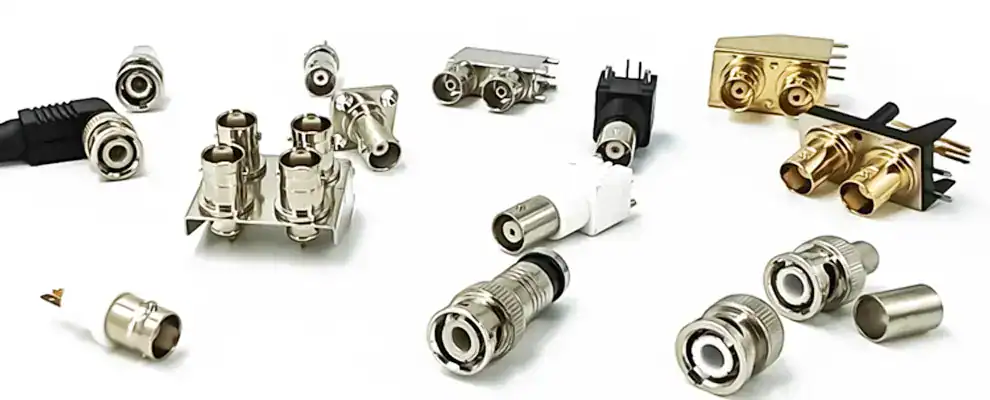Introduction
BNC connectors, widely used in coaxial cable setups for video and RF signals, have several drawbacks that manufacturers in telecom, aerospace, defense, and industrial automation must consider. While reliable for quick connections, issues like signal loss at high frequencies and vulnerability to wear can impact production lines. This article explores these disadvantages in detail, helping OEMs, contract manufacturers, and test labs evaluate options like bnc tee connector or connector rg6 bnc for better cost control and quality stability.
Understanding BNC Connectors and Their Common Types
BNC connectors, short for Bayonet Neill-Concelman, are coaxial connectors designed for easy twist-on attachment. They come in various forms, including bnc connector types such as the standard 50-ohm and 75 ohm bnc connector, which suit different impedance needs in RF applications.
Key Variants and Their Applications
Among the popular variants, the bnc t connector allows signal splitting in test environments, while the right angle bnc connector is ideal for space-constrained setups in aerospace equipment. Manufacturers often choose between bnc connector male and bnc connector female based on cable assembly requirements. For instance, a bnc connector male pairs with a female counterpart for secure links in defense systems.
In industrial automation, the cable to bnc connector or coaxial cable bnc connector ensures signal integrity over RG-series cables. Bulkhead versions like the bnc bulkhead connector provide panel-mounted solutions, and compression types such as bnc compression connector offer tool-free installation to reduce assembly time.
Pricing and Sourcing Considerations
When evaluating bnc connector price, factors like material quality and volume affect costs. High-volume orders for bnc connector coupler or bnc connector male and female can lower unit prices, but MOQs from suppliers often start at 500 units, impacting small-scale test labs. For 75 ohm bnc connector used in video surveillance, prices range from $0.50 to $2 per unit, depending on certifications.
Major Disadvantages of BNC Connectors
Despite their advantages in quick mating, BNC connectors have notable downsides that can disrupt manufacturing goals like continuous production and on-time delivery.
Signal Integrity Issues at High Frequencies
One key disadvantage is frequency limitations. BNC connectors typically handle up to 4 GHz effectively, but beyond that, signal attenuation increases. In telecom applications, this can lead to data loss in high-speed networks. For example, a study by the IEEE showed that at 10 GHz, BNC setups experience up to 3 dB more insertion loss compared to SMA connectors [1]. Manufacturers in aerospace might face this when integrating RF modules, where even minor signal degradation delays testing and raises rework costs.
To mitigate, opting for specialized variants like bnc male and female connector with enhanced shielding helps, but it doesn’t fully eliminate the issue.
Mechanical Wear and Durability Concerns
BNC connectors rely on a bayonet mechanism, which wears out after repeated cycles—typically rated for 500 mates/unmates. In defense environments with frequent field testing, this leads to connection failures, compromising quality stability. A case from a U.S. Department of Defense report highlighted how BNC wear in radar systems caused 15% downtime in simulations, forcing contract manufacturers to stock spares and inflate inventory costs .
For industrial automation, the bnc tee connector’s exposed pins are prone to bending, especially in vibration-heavy settings like robotic arms.
Size and Space Constraints
Compared to modern compact connectors, BNC types are bulkier, posing challenges in dense PCB designs. The right angle bnc connector helps somewhat, but overall footprint remains larger than alternatives like MCX. In aviation, where weight and space are critical, this adds to assembly complexity and material costs. Data from NASA’s engineering database indicates that switching from BNC to smaller connectors reduced payload weight by 5% in satellite prototypes .
Cost Implications Over Time
Initial bnc connector price seems low, but long-term expenses mount due to maintenance. For coaxial cable bnc connector in large-scale telecom deployments, frequent replacements due to corrosion in outdoor setups can exceed budget forecasts. A BBC report on network infrastructure noted that BNC-related failures contributed to 20% of annual maintenance costs in UK broadcast systems .
MOQ requirements also strain small OEMs; suppliers often demand 1,000 units minimum for custom bnc bulkhead connector, limiting flexibility in scaling production.
Compatibility and Standardization Problems
Not all BNC variants are interchangeable. Mixing 50-ohm and 75 ohm bnc connector can cause impedance mismatches, leading to reflections and signal distortion. In test labs, this mismatch once delayed a contract manufacturer’s delivery by two weeks during a defense project validation, as per a case study in the Journal of Electronic Testing [5].
The bnc connector coupler might bridge some gaps, but it introduces additional points of failure.
Case Studies: Real-World Impacts on Manufacturers
To illustrate, consider a telecom OEM integrating connector rg6 bnc in base station antennas. High-frequency demands exposed BNC’s limitations, resulting in 10% signal drop-offs during peak loads. By analyzing failure rates, they switched variants, cutting rework by 25% and improving on-time delivery.
In aerospace, a contract manufacturer for drone systems faced bnc t connector wear in vibration tests. Post-failure analysis revealed pin deformation after 300 cycles, prompting a redesign with reinforced types and better supplier tech support, stabilizing quality.
A defense lab using bnc compression connector in simulation rigs encountered compatibility issues with mixed impedances, delaying certification. Implementing strict sourcing protocols with certified suppliers resolved this, ensuring consistent press-fit performance.
Conclusion
While BNC connectors offer reliable bayonet locking for various applications, their disadvantages—ranging from frequency limits and wear to size and cost inefficiencies—can hinder manufacturers’ goals in telecom, aerospace, defense, and automation. By understanding these, OEMs and labs can explore optimized variants or alternatives, ensuring cost control, quality, and timely delivery. For technical support or sample evaluations, consulting certified suppliers with robust supply chains is key to maintaining production continuity.

 Coaxial Cable Assembly
Coaxial Cable Assembly Microwave Test Cable
Microwave Test Cable Coaxial RF Connector
Coaxial RF Connector Coaxial RF Adapter
Coaxial RF Adapter Coaxial RF Termination
Coaxial RF Termination Coaxial RF Test Probe
Coaxial RF Test Probe Coaxial RF Attenuator
Coaxial RF Attenuator RF Switch
RF Switch Coaxial RF Power Dividers
Coaxial RF Power Dividers